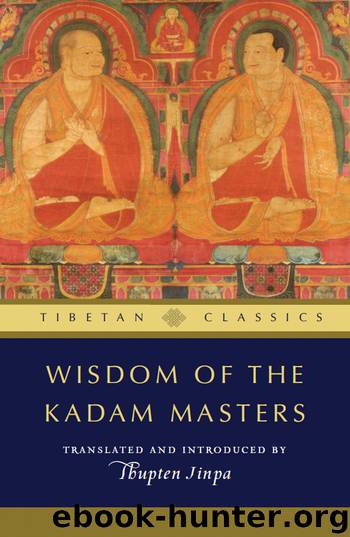Wisdom of the Kadam Masters by Thupten Jinpa

Author:Thupten Jinpa [Jinpa, Thupten]
Language: eng
Format: epub
Publisher: Wisdom Publications
Published: 0101-01-01T00:00:00+00:00
5. The Sayings of Chegom
The text of this second supplement, “The Sayings of Chegom,” is in fact composed of two separate short pieces. Both deal primarily with a trio, well known within the Tibetan tradition; namely, view, meditation, and action. This Master Chegom is undoubtedly Chegom Sherap Dorjé, editor of our main text, Sayings of the Kadam Masters. A brief biography of this master was provided at the beginning of the Sayings. Master Chegom was particularly famed for his experiential songs as well as for various pithy sayings on topics of spiritual practice. These are often organized into eighty-odd points—ten points to be remembered by beginners, eight things that one might conflate, nine nonerroneous deeds, ten potential flaws of a spiritual practitioner, five indispensable factors, seven signs of being a great being, eight practices that lead to self-imposed suffering, eight practices that constitute being kind to oneself, three perfect factors, four things that are unnecessary, and ten deeds that ensure that whatever one does becomes good.65
In the first of the two selections presented in this supplement, Chegom elegantly encapsulates what he sees to be the heart of the perfect view—to view all phenomena as representations of the mind, to view the mind as being empty of inherent existence, and not to have any form of attachment or grasping to this standpoint. This, Master Chegom says, is the ultimate view. Similarly, the ultimate meditation refers to placing one’s mind, free of distraction, in a natural uncontrived state wherein nothing is objectified, either with respect to the outside world or the internal world of one’s experience. Thirdly, the ultimate action or conduct, which emerges from a view and meditation such as this, is to act and be in the world with no judgment of rejection or affirmation, and yet to transform all adversity into the path and to have no attachment to favorable conditions. This is a vision of a life of true nonattachment. Master Chegom then goes on to envision what kind of a spiritual path will emerge from such a state of being, and what its immediate and ultimate results will be. Finally, we are reminded that in the final analysis all of these must be understood within the framework of emptiness, the ultimate nature of all things. This will ensure that we do not become stuck through grasping and instead relate to our experience and the world around us as being echo-like, dream-like, with no substantial reality to cling to.
The second text presents the same theme of view, meditation, and action from the perspective of its more graduated development under the rubric of what the master calls the “ten perfect factors.” Among these ten there is a view of the initial level, of the medium level, and of the highest; a meditation of the initial, medium, and highest levels; and an action of the initial, medium, and highest levels. The final tenth factor we might see as the sign indicating success in one’s practice. Thus Chegom speaks of the
Download
This site does not store any files on its server. We only index and link to content provided by other sites. Please contact the content providers to delete copyright contents if any and email us, we'll remove relevant links or contents immediately.
The Way of Zen by Alan W. Watts(6294)
Ego Is the Enemy by Ryan Holiday(4968)
The Art of Happiness by The Dalai Lama(3854)
The Book of Joy by Dalai Lama(3712)
Why Buddhism is True by Robert Wright(3291)
Spark Joy by Marie Kondo(3092)
Shift into Freedom by Loch Kelly(3033)
Happiness by Matthieu Ricard(2891)
A Monk's Guide to a Clean House and Mind by Shoukei Matsumoto(2787)
The Lost Art of Good Conversation by Sakyong Mipham(2447)
The Meaning of the Library by unknow(2396)
The Third Eye by T. Lobsang Rampa(2175)
The Unfettered Mind: Writings from a Zen Master to a Master Swordsman by Takuan Soho(2162)
Red Shambhala by Andrei Znamenski(2075)
Anthology by T J(2049)
The Diamond Cutter by Geshe Michael Roach(1959)
Thoughts Without A Thinker: Psychotherapy from a Buddhist Perspective by Epstein Mark(1901)
Advice Not Given by Mark Epstein(1768)
Twilight of Idols and Anti-Christ by Friedrich Nietzsche(1766)
